
October 14th, 2014 by Dr. Val Jones in Health Policy, True Stories
Tags: Censeo Health, CenseoHealth, Dangers, False Advertising, Frail Elderly, Geriatrics, Health Insurance Companies, Managed Medicare Plans, Medical Missionary, Medicare Advantage Evaluations, Part Time Work, Physician Jobs, Poverty
3 Comments »
Physicians looking for part-time jobs to supplement their income may have run across advertisements for “lucrative” Medicare Advantage evaluation opportunities at CenseoHealth. Here’s a typical ad:
|

CenseoHealth is the leading Risk Adjustment provider for Medicare Advantage plans – with a network of more than 1,800 credentialed providers conducting over 20,000 member health evaluations a month. Due to our continued growth, we are currently looking to hire in-home physician evaluators to work in these states.
As a CenseoHealth physician, you will meet with Medicare Advantage members in their homes to conduct their annual medical history and physical evaluation.
Additional Information:
-
Conduct evaluations when it’s convenient for you
-
Ongoing physicians can make $3,500 to $4,000 per week
-
Physicians who work 1-3 days per week can make $800 – $2,000
-
Travel and lodging expenses are covered, plus we provide a per diem reimbursement
-
Malpractice insurance is included
-
This position does not require you to prescribe medicine, order lab tests, do blood work, or alter the member’s current treatment regimen
Please contact us, for more information.
Bryan Cooke
Director of Physician Recruiting
P: 972.715.3772
E: physicians@censeohealth.com
|
|
Sounds pretty good, right? Well here’s what they won’t tell you:
1. Low Hourly Pay. Compensation is $100 per completed evaluation – but you have to drive to each member’s house (sometimes an hour each way) to complete a 31 page history and physical exam. Members are often medically complex, cognitively impaired, and/or non-English speaking. In the end (after counting travel time, cancellations, scheduling snafus, and long hours completing paperwork and FedEx shipping) the hourly wage works out to be about $30.
2. Poor Logistics. Members are scheduled back-to-back without regard to distance between their locations. That means you are chronically late, and some members cancel their meeting with you. No-show and cancellation rates (in my experience) are about 20%. You are not compensated for any of the time associated with driving to their location, talking to them on the phone, or otherwise trying to locate them when they are not home upon your arrival. Once a member cancels, you cannot fill their slot with someone else on the same day.
3. Threat of harm. Members mostly come from low to middle class income levels. Some of them live in truly horrific living situations (no electricity, a home overrun with cockroaches, no food or running water), and others are psychologically unstable. As a female physician driving alone into a very rural area to conduct a physical exam on a male patient who is actively psychotic… this can be dangerous. You never know what or who you will face. I have had to call social services on numerous occasions and have narrowly escaped inappropriate sexual advances.
4. Limited Support. There is no guarantee that anyone from the parent company will be available via phone when you call during an emergency. I have called on several occasions during critical situations where I had to leave a voice message and was assured that “my call was very important” and someone from provider services “would get back to me within 1/2 a business day.”
5. Questionable ethics. Schedulers do not explain to the members why you are coming to their home to evaluate them. Because the schedulers seem to work on commission, they often use questionable tactics to get the members to agree to the evaluation – such as telling them that the meeting is “mandatory” and will “take 20 minutes” or is “just a wellness visit.” For this reason, many members receive you with suspicion, wondering if you’re there to try to “throw them off the Medicare plan” or are angry that they were mandated to meet with you. Lengthy conversations and apologies to set the stage for your evaluation are commonplace.
6. Payment denials and exaggerated pay potential. Evaluations must be completed meticulously or the quality assurrance reviewers will reject your forms and you will not be compensated for your work (if you, for example, forget to check a box or use a non-approved abbreviation). Although the advertisements state that some physicians complete 35-45 evaluations per week, that is nearly impossible in areas where clients are not clustered together tightly. It is an extremely misleading statement, in my experience. Apparently online reviewers agree.
7. Glitchy and costly technology. In order to save on costs, electronic evaluations can be completed via an iPad rather than paper forms. Unfortunately, the software often crashes, resulting in a return to paper in the middle of an evaluation. This ends up increasing the amount of time required to complete evaluations as your evenings are spent copying paper records into the iPad program. In addition, you are required to purchase your own stylus for data entry, as well as all the equipment required during your physical exam (e.g. blood pressure cuff, bathroom scale, ophthalmoscope, stethoscope, and more).
8. Low-budget travel and accommodations. While the agency boasts that they will pay for your accommodations and rental car, that typically translates into a room at a low-budget hotel and a Toyota Yaris with roll-down windows and no GPS.
9. The truth is hidden. The real reason for the evaluations is to help health insurers obtain larger reimbursements from the government. A physician (or NP) is required to verify all of the patient’s current medical conditions to justify their “risk score.” Medicare Advantage plans get paid more to manage patients with higher risk scores, so they are very motivated to document the complete list of diseases and conditions per at-risk senior. Patients may benefit from having an objective third party review their health record, but this is not the main goal. Also, it is unclear if the higher risk scores ultimately translate to more benefits and services for the patients.
10. Treated like a number. Sadly, my experience with my recruiter (the person who matches your availability with evaluation needs in various states where you hold a medical license) has been underwhelming. I took the time to make suggestions about how to improve the process for evaluators, but my recommendations fell on deaf ears. Not only were my phone calls and emails not returned, but when I suggested that it didn’t make sense for me to continue seeing members when I had a 66% no-show rate he simply replied, “I took you off the schedule – we have an abundance of FL doctors so it is not an issue.”
Take a look at the lovely marketing promotional images for the job:
And this video of what it’s like to do a home evaluation:
Now take a look at some photos that I took while on assignment (note: these are not actual patient homes, but are very similar to ones I encountered):



Taking a job as a Medicare Advantage evaluator was a real eye-opener. Poverty and chronic illness in America takes on a whole new light when you experience patients’ actual home environments. It’s like being a medical missionary in your own country. I’ve met patients who hadn’t seen a physician in decades, diagnosed life-threatening illnesses, and made sure that care (or case management) was initiated for countless people living on the fringes of society.
I’m glad for the experience – but think that my peers considering similar work should be told the truth about what they will be doing. Being a Medicare Advantage evaluator is not like the shiny “care anywhere” ad suggests – and “lucrative” is not exactly the right adjective for $30/hour for an MD’s time. But if you don’t mind being treated poorly by your employer, investing a lot of your own money in equipment costs, and putting your life at risk in dangerous home environments – you may actually do some good for the forgotten, frail elderly of this nation, (while helping middle men like Censeo Health to profit from health insurance behemoths, alas). Now you know the truth behind the advertising and can make an informed decision about whether or not you’d like to sign up for this work.
Any takers?
July 14th, 2014 by Dr. Val Jones in Opinion, True Stories
Tags: Benefits, Cancer, Colonoscopy, Guidelines, Harms, Mammogram, Over-testing, Over-treatment, Screening Tests, USPSTF
3 Comments »
 Health screening is part of good preventive care, though over-screening can lead to increased costs, and potential patient harm. Healthcare professional societies have recently developed excellent public service announcements describing the dangers of over-testing, and new research suggests that though additional medical interventions are associated with increased patient satisfaction, they also lead (ironically) to higher mortality rates.
Health screening is part of good preventive care, though over-screening can lead to increased costs, and potential patient harm. Healthcare professional societies have recently developed excellent public service announcements describing the dangers of over-testing, and new research suggests that though additional medical interventions are associated with increased patient satisfaction, they also lead (ironically) to higher mortality rates.
And so, in a system attempting to shift to a “less is more” model of healthcare, why is resistance so strong? When the USPSTF recommended against the need for annual, screening mammograms in healthy women (without a family history of breast cancer) between the ages of 40-49, the outcry was deafening. Every professional society and patient advocacy group rallied against the recommendation, and generally not much has changed in the breast cancer screening world. I myself tried to follow the USPSTF guidelines – and opted out of a screening mammogram for two full years past 40. And then I met a charming radiologist at a women’s medical conference who nearly burst into tears when I told her that I hadn’t had a mammogram. Her lobbying for me to “just make sure I was ok” was so passionate that I simply could no longer resist the urge to get screened.
I knew going into the test that there was a reasonably high chance of a false positive result which could cause me unnecessary anxiety. That being said, I was still emotionally unprepared for the radiologists’ announcement that the mammogram was “abnormal” and that a follow up ultrasound needed to be scheduled. I must admit that I did squirm until I had more information. In the end, the “abnormality” proved to be simple “dense breast tissue” and I was pleased to have at least dodged an unnecessary biopsy or lumpectomy. Did my screening do me any good? No, and some psychological harm. A net/net negative but without long term sequelae.
My next personal wrestling match with screening tests was the colonoscopy. I was seeing a gastroenterologist for some GI complaints, and we weren’t 5 minutes into our conversation before he recommended a colonoscopy. I argued that I was too young for a screening colonoscopy (I was 42 and they are recommended starting at age 50), and therefore was doubtful that anything too helpful would be found with the test. My suggestion was that a careful history and some blood testing might be the first place to start. My gastroenterologist acquiesced reluctantly.
As it turns out the blood testing was non-diagnostic and my symptoms persisted so I agreed to the colonoscopy. In this case I felt it was reasonable to do it since it was for diagnostic (not screening) purposes. I was quite certain that it would reveal nothing – or perhaps a false positive followed by anxiety, like my mammogram.
What it did show was some polyps that had a 50% chance of becoming malignant colon cancer in the next 10 years. I was shocked. If I had waited until I was 50 to start screening, I could have missed my cure window. The uneasiness about screening guidelines began to sink in. As a physician I had done my best to apply screening guidelines to myself and resist the urge to over-test, even with a healthy dose of natural curiosity. Yet I failed to resist screening, and in fact, my life was possibly saved by a test that was not supposed to be on my preventive health radar for another 8 years.
 Screening tests are recommended for those who are most likely to benefit, and physicians and patients alike are encouraged to avoid unnecessary testing. But there are always a few people outside the “most likely to benefit” pool whose lives could be saved with screening, and the urge to make sure that’s not you – or your patient – is incredibly strong. I’m not sure if that’s human nature, or American culture. But a quick review of Hollywood blockbuster plots (where tens of thousands of lives are regularly sacrificed to save one princess/protagonist/hero from the aliens/monsters/zombies) testifies to our desperately irrational tendencies.
Screening tests are recommended for those who are most likely to benefit, and physicians and patients alike are encouraged to avoid unnecessary testing. But there are always a few people outside the “most likely to benefit” pool whose lives could be saved with screening, and the urge to make sure that’s not you – or your patient – is incredibly strong. I’m not sure if that’s human nature, or American culture. But a quick review of Hollywood blockbuster plots (where tens of thousands of lives are regularly sacrificed to save one princess/protagonist/hero from the aliens/monsters/zombies) testifies to our desperately irrational tendencies.
I am now biased towards over-testing, because my emotional relief at dodging a bullet is stronger than my cerebral desire to adhere to population-based recommendations. Knowing this, I will still try to avoid the temptation to over-test and over-treat my patients. But if they so much as hint that they’d like an early colonoscopy – I will cave.
Does that make me a bad doctor?
July 10th, 2014 by Dr. Val Jones in Opinion, True Stories
Tags: Bad Bedside Manner, Bad Doctors, Colonoscopy, Compassion, Empathy, Gastroenterologist, Lack, Lack of Caring
6 Comments »
 I am a regular reader of patient blogs, and I find myself frequently gasping at the mistreatment they experience at the hands of my peers. Yesterday I had the “pleasure” of being a patient myself, and found that my professional ties did not protect me from outrageously poor bedside manners. I suppose I’m writing this partly to vent, but also to remind healthcare professionals what not to do to patients waking up from anesthesia. I also think my experience may serve as a reminder that it’s ok to fire your doctor when conditions warrant.
I am a regular reader of patient blogs, and I find myself frequently gasping at the mistreatment they experience at the hands of my peers. Yesterday I had the “pleasure” of being a patient myself, and found that my professional ties did not protect me from outrageously poor bedside manners. I suppose I’m writing this partly to vent, but also to remind healthcare professionals what not to do to patients waking up from anesthesia. I also think my experience may serve as a reminder that it’s ok to fire your doctor when conditions warrant.
I chose my gastroenterologist based on his credentials and the quality of training and experience listed on Healthgrades.com I had no personal recommendations to rely upon – so I used what I thought was a reasonable method for finding a good local doctor. When I met him for our initial office consultation he seemed rushed and distracted, without genuine curiosity about my complaints, complicated history, or how to help me find the correct diagnosis. I brushed my instincts aside, presuming he was just having a “bad day” and hoping for more time to discuss things fully once a battery of blood tests had been completed.
Sadly, I didn’t have the chance to review the results with him – instead he instructed his nurse to read me the results over the phone and to schedule me for a colonoscopy. I wanted to discuss the pros and cons of the procedure and what he thought he might be able to rule out with the test. He did not provide me with basic informed consent information, nor was he able to articulate medical necessity for the scope. I decided not to have the test, and I didn’t hear another word from him or his office.
Months later my symptoms had worsened and so I decided that a colonoscopy might help to further elucidate the potential cause. I was not able to get through to my doctor via phone, so I scheduled the test via his nursing staff. I planned to be the first patient of the day, so that we would have time to discuss my symptoms and concerns.
On the day of the procedure my physician stormed into my surgical bay and began reading my medical history to me from the computer screen, without exchanging basic niceties or introducing himself to my husband. I confirmed the information and tried to offer some nuance since our last office meeting. He cut me off, and made me feel as if my observations were completely unhelpful and were getting in the way of our scope time. He left in a rush before I felt that he had any clear sense of what we were trying to accomplish or rule out with the procedure.
A jovial anesthesiologist then entered my curtained cubicle, and made genuine human contact with me. He inquired about the reasons for the procedure and expressed appropriate glee regarding my Mallampati grade I airway. I asked him if he would be so kind as to not position me directly on my left shoulder during the procedure as it was exquisitely tender from a recent orthopedic injury. He promised to do his best to protect the injury while I was sedated.
Cut to the endoscopy suite where the gastroenterologist enters with a grumble as the techs bustle around the scope equipment and the anesthesiologist explains the slightly altered positioning for my comfort. As the propofol anesthetic goes into my vein I feel the gastroenterologist push me fully onto my injury as I lose the ability to protest.
After the procedure I’m back in my bay with my husband, groggy but with more pain in my shoulder than anywhere else. The curtain is drawn back with a yank and in marches the GI doc, relaying the unanticipated abnormal findings. I ask (in a slightly slurred tone) for more information, to which he responds in a loud voice, “You’re not going to remember any of this so just be quiet and listen!”
I persist in my attempts to understand the details to which he shouts “Shut up and listen” with increasing decibels. When I say that the findings still don’t explain my symptoms and that I remain perplexed he says that I should “try probiotics.” Finally he leaves the room, not offering any reassurance about the possibility of bowel perforation and stating that we’ll “Just have to wait for the pathology report, and it will take a while because of the July 4th weekend.”
I was dumbfounded, and not just because of my post-anesthetic stupor, but because of the open hostility showed to me by one of my peers. I asked my husband if I was out of line in my questioning and he said that I sounded “like a drunk person” but that the doctor was definitely being “an a**hole.”
As the nurses untangled me from the IV and EKG stickers and rushed me into a wheelchair and out to my husband’s waiting vehicle, all I could say was “Wow, my gastroenterologist was really mean to me.”
The nurses just nodded and suggested that I wasn’t the first to notice that.
As I recover from the whirlwind interaction with the healthcare system, I feel relief and anger. I’m relieved that my GI doc didn’t perforate my bowel and that we accidentally caught some very bad stuff early on, but I’m angry about how I was treated and feel no closer to an explanation for my symptoms than when I started investigating a year ago. My experience was probably fairly typical for many patients dealing with physicians who have lost empathy and compassion. I am sad that there are so many like that out there and I promise to do my best not to follow suit.
My bottom line on gastroenterologists (sorry for the horrible pun): Go with your gut. If your doctor displays jerk-like tendencies during your office visit, rest assured that they can bloom in time. Have the courage to find another doctor before you put your life in their hands and/or they get the chance to verbally abuse you in a post-anesthetic stupor. I am firing my doctor a little bit on the late side, but doing it nonetheless. I just hope that my orthopedist is a good egg (like my anesthesiologist) – because I’ve got one heck of a sore shoulder coming his way!
April 25th, 2014 by Dr. Val Jones in Opinion, True Stories
Tags: EMR, Float Nurse, Fragmentation Of Care, Hospitalists, Inpatient Medicine, Medical Errors, Medical Home, Primary Care, rehab, Shift Work, Shift Workers
No Comments »
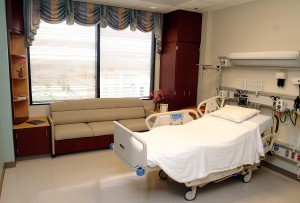 If you (or a loved one) have been admitted to a hospital recently, you were probably surprised by the number of times you were asked the same questions. At first you might assume that the staff are being diligent in double-checking your information, but after the fifth healthcare provider asks you to explain why you’re there, you start to feel as if interacting with “the system” is like talking to a person with no short term memory. It’s as if the hospital itself has some kind of dementia.
If you (or a loved one) have been admitted to a hospital recently, you were probably surprised by the number of times you were asked the same questions. At first you might assume that the staff are being diligent in double-checking your information, but after the fifth healthcare provider asks you to explain why you’re there, you start to feel as if interacting with “the system” is like talking to a person with no short term memory. It’s as if the hospital itself has some kind of dementia.
Recent adoption of electronic data collection, shift working, team management, and over-specialization have exponentially increased the complexity of patient care. Unfortunately, the complexity is fueling medical errors, repeat and unnecessary testing, as well as misdiagnoses. As primary care physicians have eloquently argued, being cared for by those who don’t know you can be a huge cost driver, and create all manner of unnecessary anxiety. Perhaps a true story will help to illustrate my point?
Not too long ago, I was caring for a patient in an acute rehab unit. Over a three week period of time I got to know her idiosyncrasies quite well. She had had a recent chest surgery and the surgical site was exquisitely tender, but without evidence of infection. In addition, she was allergic to certain kinds of tape and had had an unfortunate blistering reaction to the tape that had been near her surgical site. She had anxiety disorder that was well managed with medicine and talk therapy. She had a large family who visited her daily, some of whom had decided not to vaccinate their children. I had spent a good deal of time helping them to understand the risks associated with those choices.
I signed out my patient’s care to the weekend hospitalist team on Friday afternoon, and was alarmed to discover my patient in an isolation room on Monday morning, in the midst of a nervous breakdown, and surrounded by gowned family members who were furiously calling for emergency transport of distant children to various hospitals. I had not heard a peep from the hospitalists about events over the weekend, and immediately gowned up to find out what was going on.
My patient sobbed, “The doctor told me I have shingles. Now my grand children are going to get chicken pox and they’ll have brain damage!”
“Which doctor told you that you have shingles?” I asked.
“I don’t know his name. Some doctor who was here this weekend,” she wailed.
“How did he know you had shingles?” I said, sitting down next to her bed, trying to console her.
“He looked at my chest rash.” She replied, pointing to the patch of contact dermatitis at the site of the recent surgical tape removal. “He asked me if it was painful and I said ‘yes.'”
“But it’s the surgery site that’s painful as it has always been, right?” I said.
“Yes, it’s the same pain.”
It dawned on me that a linear patch of painful blisters did look a lot like shingles, especially to someone who had never seen the patient before. I could see why the hospitalist suspected it, but unfortunately he wasn’t aware of her long standing wound tenderness or tape reaction. The fallout from this well-meaning misdiagnosis was especially large, given the psycho-social context. A large, anxious family, with many unvaccinated kids who had traveled from far away to see grandma in the rehab unit over the weekend. It was the perfect storm.
Needless to say, it took me several days to unravel the damage, reassure the family, and recall the “emergency chicken pox” ER visits that were planned in distant parts of the state (where the kids made their home). The pregnant nurse who was treating the patient over the weekend had to create a full report to employee health about her “high risk encounter.” And in the end, the family and nursing staff didn’t feel completely certain that she didn’t have shingles, since it was officially documented in the EMR by at least one physician, no matter what my argument.
This is just one example of how cross-sectional relationships with patients (rather than the preferred, longitudinal kind), can wreak havoc. Because of the incredible degree of turnover inherent in today’s inpatient care systems, patients are examined “from scratch” by every new shift of nurse, physician, physical therapist, case manager, etc. There is very little context available to assist with interpreting how the patient is doing compared to their previous state. Searching for such pearls can be time consuming in a medical chart that is not designed for clear communication, but billing purposes.
What are we to do when faced with a new patient with a concerning complaint? Search the chart for historical clues, look for a staff member who has known them longer than one shift, or perhaps ask the patient:
“So can you tell me again why you came to the hospital?”
April 21st, 2014 by Dr. Val Jones in Opinion, True Stories
Tags: Communication, Data, EHR, Electronic Hospital Records, Electronic Medical Records, EMR, Errors, Medical Errors, Near Misses, Patient Care
2 Comments »
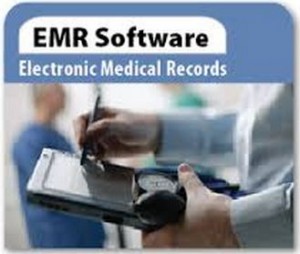 For the past couple of years I’ve been working as a traveling physician in 13 states across the U.S. I chose to adopt the “locum tenens lifestyle” because I enjoy the challenge of working with diverse teams of peers and patient populations. I believe that this kind of work makes me a better doctor, as I am exposed to the widest possible array of technology, specialist experience, and diagnostic (and logistical) conundrums. During my down times I like to think about what I’ve learned so that I can try to make things better for my next group of patients.
For the past couple of years I’ve been working as a traveling physician in 13 states across the U.S. I chose to adopt the “locum tenens lifestyle” because I enjoy the challenge of working with diverse teams of peers and patient populations. I believe that this kind of work makes me a better doctor, as I am exposed to the widest possible array of technology, specialist experience, and diagnostic (and logistical) conundrums. During my down times I like to think about what I’ve learned so that I can try to make things better for my next group of patients.
This week I’ve been considering how in-patient doctoring has changed since I was in medical school. Unfortunately, my experience is that most of the changes have been for the worse. While we may have a larger variety of treatment options and better diagnostic capabilities, it seems that we have pursued them at the expense of the fundamentals of good patient care. What use is a radio-isotope-tagged red blood cell nuclear scan if we forget to stop giving aspirin to someone with a gastrointestinal bleed?
At the risk of infecting my readers with a feeling of helplessness and depressed mood, I’d like to discuss my findings in a series of blog posts. Today’s post is about why electronic medical charts have become ground zero for deteriorating patient care.
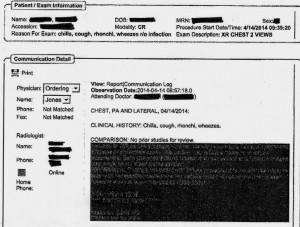
EMR Alert - Featuring radiologist note in illegible font color
1. Medical notes are no longer used for effective communication, but for billing purposes. When I look back at the months of training I received at my alma mater regarding the proper structure of intelligent medical notes, I recall with nostalgia how beautiful they were. Each note was designed to present all the observed and collected data in a cohesive and logical format, justifying the physician’s assessment and treatment plan. Our impressions of the patient’s physical and mental condition, reasons for further testing, and our current thought processes regarding optimal treatments and follow up (including citation of scientific literature to justify the chosen course) were all crisply presented.
Nowadays, medical notes consist of randomly pre-populated check box data lifted from multiple author sources and vomited into a nonsensical monstrosity of a run-on sentence. It’s almost impossible to figure out what the physician makes of the patient or what she is planning to do. Occasional “free text” boxes can provide clues, when the provider has bothered to clarify. One needs to be a medical detective to piece together an assessment and plan these days. It’s both embarrassing and tragic… if you believe that the purpose of medical notes is effective communication. If their purpose is justifying third-party payer requirements, then maybe they are working just fine?
My own notes have been co-opted by the EMRs, so that when I get the chance to free-text some sensible content, it still forces gobbledygook in between. I can see why many of my peers have eventually “given up” on charting properly. No one (except coders and payers interested in denying billing claims) reads the notes anymore. The vicious cycle of unintelligible presentation drives people away from reading notes, and then those who write notes don’t bother to make them intelligent anymore. There is a “learned helplessness” that takes over medical charting. All of this could (I suppose) be forgiven if physicians reverted back to verbal handoffs and updates to other staff/peers caring for patients to solve this grave communication gap. Unfortunately, creating gobbledygook takes so much time that there is less old fashioned verbal communication than ever.
2. No one talks to each other anymore. I’m not sure if this is because of a general cultural shift away from oral communication to text-based, digital intermediaries (think zombie-like teens texting one another incessantly) or if it’s related to sheer time constraints. However, I am continually astonished by the lack of face-to-face or verbal communication going on in hospitals these days. When I first observed this phenomenon, I attributed it to the facility where I was working. However, experience has shown that this is an endemic problem in the entire healthcare system.
When you are overworked, it’s natural to take the path of least resistance – checking boxes and ordering consults in the EMR is easier than picking up a phone and constructing a coherent patient presentation to provide context for the specialist who is about to weigh in on disease management. Nursing orders are easier to enter into a computer system than actually walking over and explaining to him/her what you intend for the patient and why.
But these shortcuts do not save time in the long run. When a consultant is unfamiliar with the partial workup you’ve already completed, he will start from the beginning, with duplicate testing and all its associated expenses, risks, and rabbit trails. When a nurse doesn’t know that you’ve just changed the patient to “NPO” status (or for what reason) she may give him/her scheduled medications before noticing the change. When you haven’t explained to the physical therapists why it could be dangerous to get a patient out of bed due to a suspected DVT, the patient could die of a sudden pulmonary embolism. Depending upon computer screen updates for rapid changes in patient care plans is risky business. EMRs are poor substitutes for face-to-face communication.
In one case I remember a radiology tech expressing amazement that I had bothered to type the reason for the x-ray in the order field. How can a radiologist be expected to rule out something effectively if he isn’t given the faintest hint about what he’s looking for? On another occasion I called to speak with the radiologist on a complicated case where the patient’s medical history provided him with a clue to look for something he hadn’t thought of – and his re-read of the CT scan led to the discovery and treatment of a life-threatening disease. Imagine that? An actual conversation saved a life.
3. It’s easy to be mindless with electronic orders. There’s something about the brain that can easily slip into “idle” mode when presented with pages of check boxes rather than a blank field requiring original input. I cannot count the number of times that I’ve received patients (from outside hospitals) with orders to continue medications that should have been stopped (or forgotten medications that were not on the list to be continued). In one case, for example, a patient with a very recent gastrointestinal bleed had aspirin listed in his current medication list. In another, the discharging physician forgot to list the antibiotic orders, and the patient had a partially-treated, life-threatening infection.
As I was copying the orders on these patients, I almost made the same mistakes. I was clicking through boxes in the pharmacy’s medication reconciliation records and accidentally approved continuation of aspirin (which I fortunately caught in time to cancel). It’s extremely unlikely that I would have hand-written an order for aspirin if I were handling the admission in the “old fashioned” paper-based manner. My brain had slipped into idle… my vigilance was compromised by the process.
In my view, the only communication problem that EMRs have solved is illegible handwriting. But trading poor handwriting for nonsensical digital vomit isn’t much of an advance. As far as streamlining orders and documentation is concerned, yes – ordering medications, tests, and procedures is much faster. But this speed doesn’t improve patient care any more than increasing the driving speed limit from 60 mph to 90 mph would reduce car accidents. Rapid ordering leads to more errors as physicians no longer need to think carefully about everything. EMRs have sped up processes that need to be slow, and slowed down processes that need to be fast. From a clinical utility perspective, they are doing more harm than good.
As far as coding and billing are concerned, I suppose they are revolutionary. If hospital care is about getting paid quickly and efficiently then perhaps we’re making great strides? But if we are expecting EMRs to facilitate care quality and communication, we’re in for a big disappointment. EMRs should have remained a back end billing tool, rather than the hub of all hospital activity. It’s like using Quicken as your life’s default browser. Over-reach of this particular technology is harming our patients, undermining communication, and eroding critical thinking skills. Call me Don Quixote – but I’m going to continue tilting at the hospital EMR* windmill (until they are right-sized) and engage in daily face-to-face meetings with my peers and hospital care team.
*Note: there is at least one excellent, private practice EMR (called MD-HQ). It is for use in the outpatient setting, and is designed for communication (not billing). It is being adopted by direct primary care practices and was created by physicians for supporting actual thinking and relevant information capture. I highly recommend it!
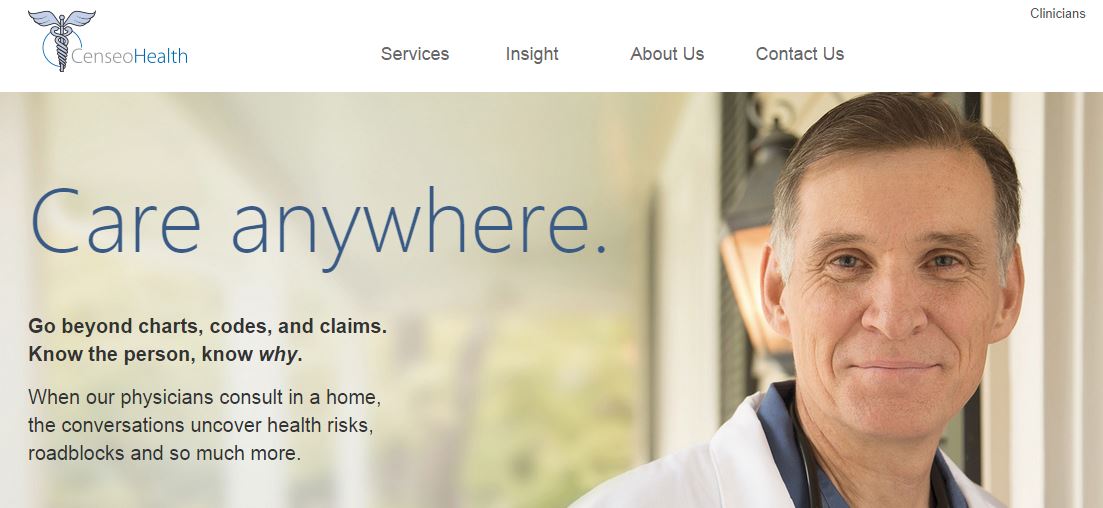
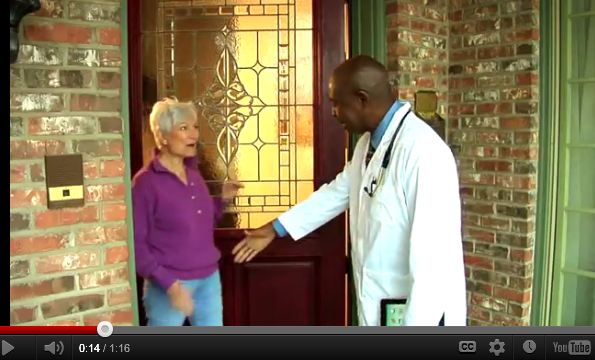









 Screening tests are recommended for those who are most likely to benefit, and physicians and patients alike are encouraged to avoid unnecessary testing. But there are always a few people outside the “most likely to benefit” pool whose lives could be saved with screening, and the urge to make sure that’s not you – or your patient – is incredibly strong. I’m not sure if that’s human nature, or American culture. But a quick review of Hollywood blockbuster plots (where tens of thousands of lives are regularly sacrificed to save one princess/protagonist/hero from the aliens/monsters/zombies) testifies to our desperately irrational tendencies.
Screening tests are recommended for those who are most likely to benefit, and physicians and patients alike are encouraged to avoid unnecessary testing. But there are always a few people outside the “most likely to benefit” pool whose lives could be saved with screening, and the urge to make sure that’s not you – or your patient – is incredibly strong. I’m not sure if that’s human nature, or American culture. But a quick review of Hollywood blockbuster plots (where tens of thousands of lives are regularly sacrificed to save one princess/protagonist/hero from the aliens/monsters/zombies) testifies to our desperately irrational tendencies. I am a regular reader of patient blogs, and I find myself frequently gasping at the mistreatment they experience at the hands of my peers. Yesterday I had the “pleasure” of being a patient myself, and found that my professional ties
I am a regular reader of patient blogs, and I find myself frequently gasping at the mistreatment they experience at the hands of my peers. Yesterday I had the “pleasure” of being a patient myself, and found that my professional ties  If you (or a loved one) have been admitted to a hospital recently, you were probably surprised by the number of times you were asked the same questions. At first you might assume that the staff are being diligent in double-checking your information, but after the fifth healthcare provider asks you to explain why you’re there, you start to feel as if interacting with “the system” is like talking to a person with no short term memory. It’s as if the hospital itself has some kind of dementia.
If you (or a loved one) have been admitted to a hospital recently, you were probably surprised by the number of times you were asked the same questions. At first you might assume that the staff are being diligent in double-checking your information, but after the fifth healthcare provider asks you to explain why you’re there, you start to feel as if interacting with “the system” is like talking to a person with no short term memory. It’s as if the hospital itself has some kind of dementia. For the past couple of years I’ve been working as a traveling physician in 13 states across the U.S. I chose to adopt the “
For the past couple of years I’ve been working as a traveling physician in 13 states across the U.S. I chose to adopt the “










